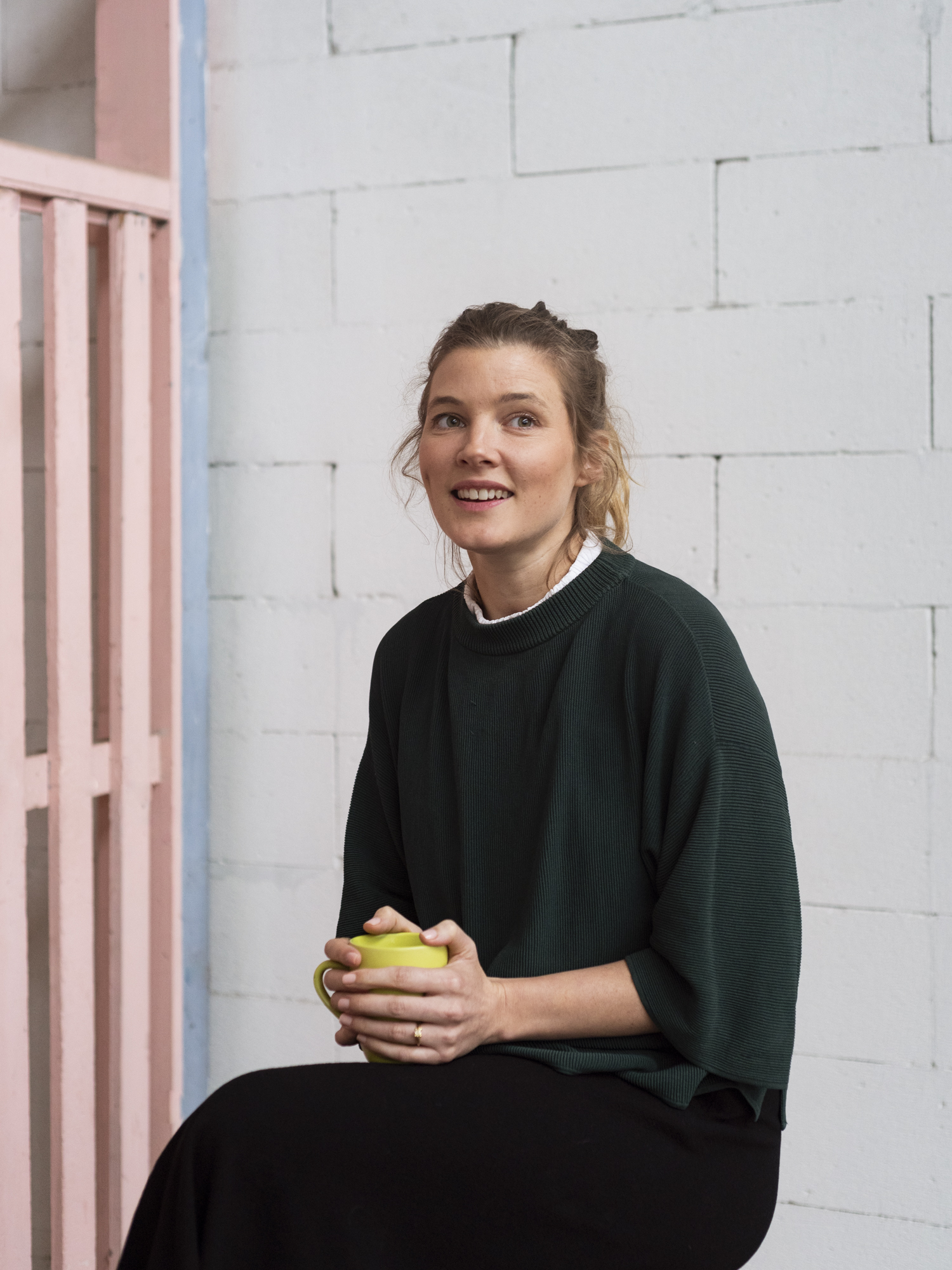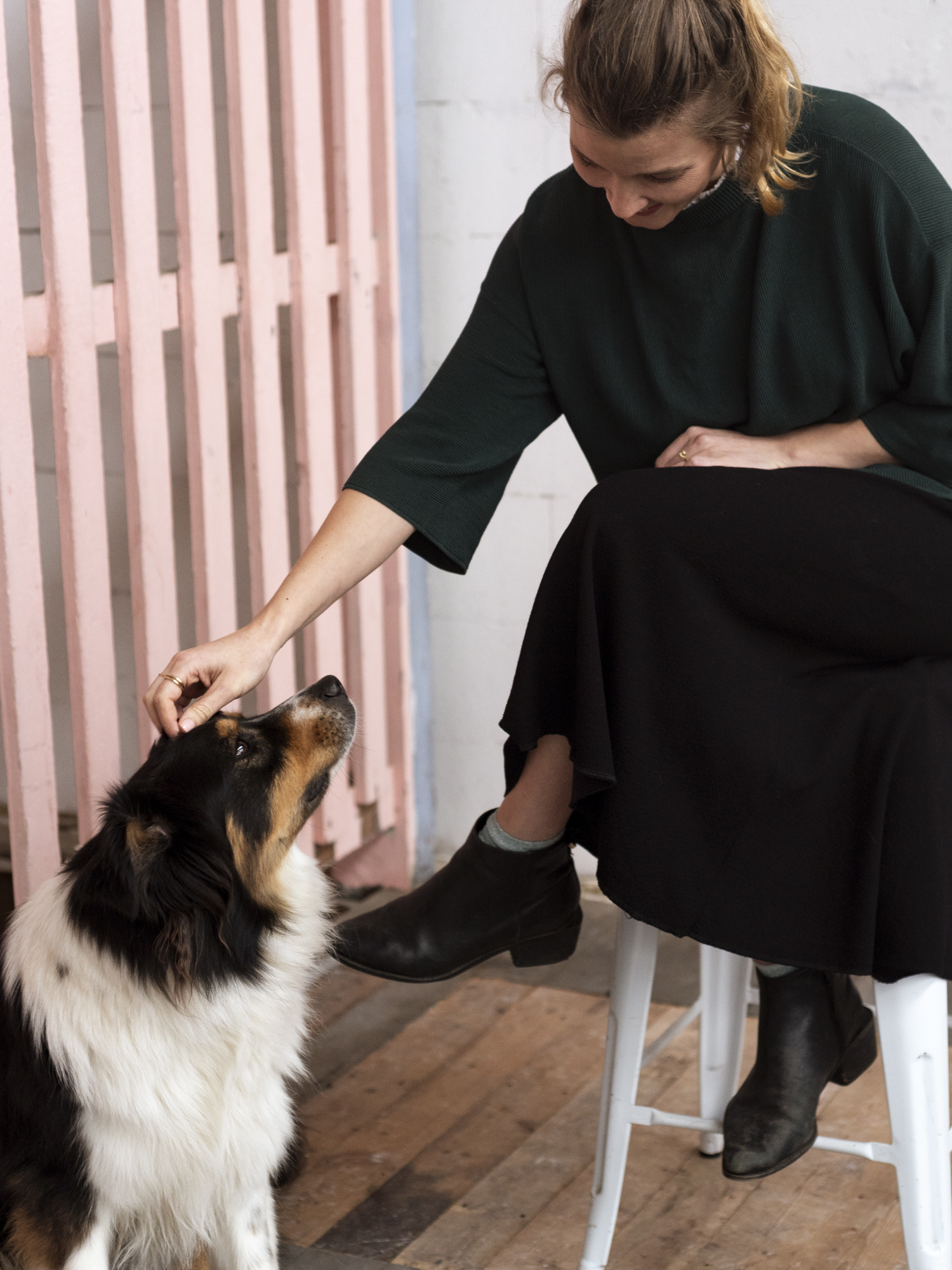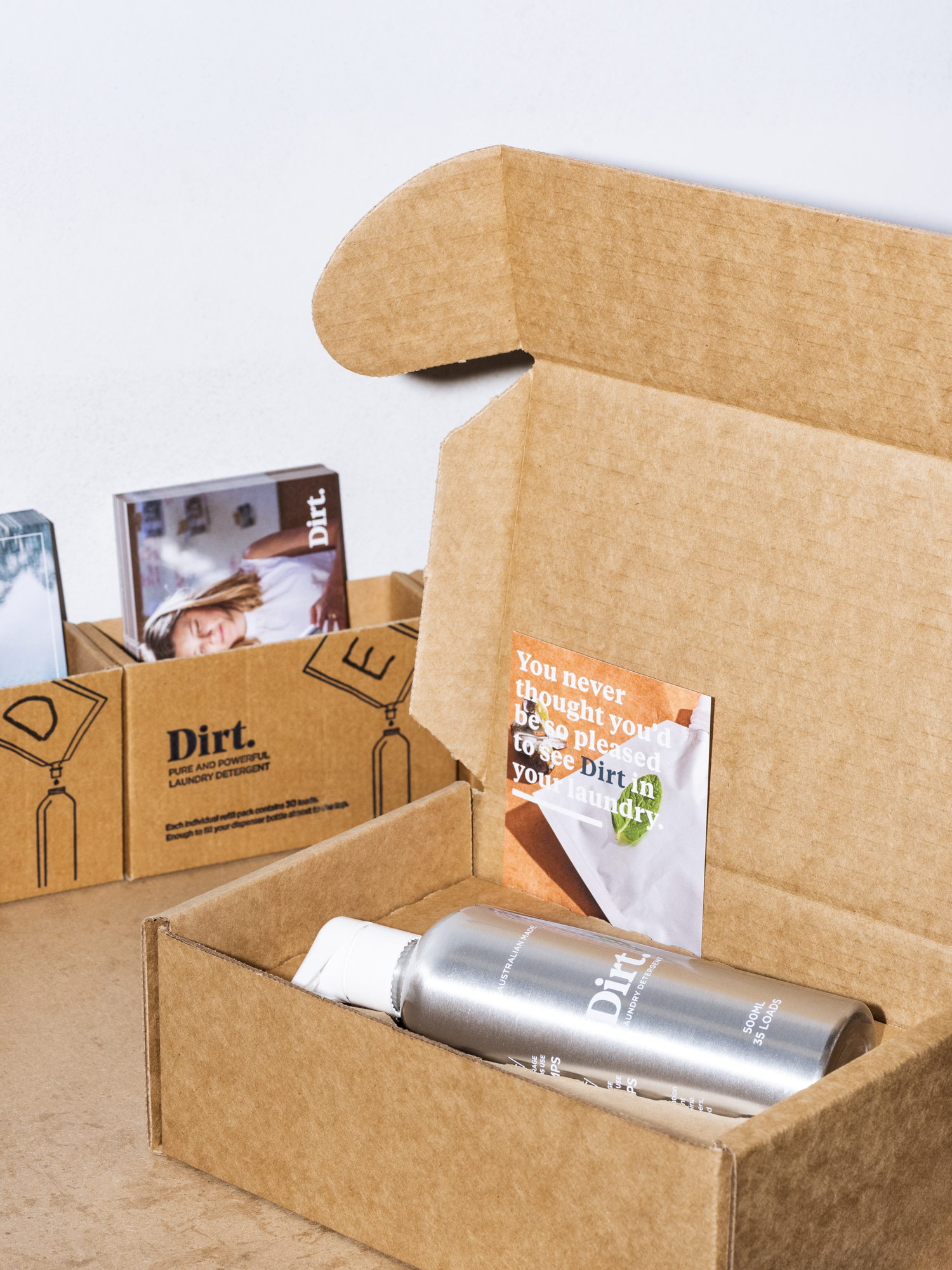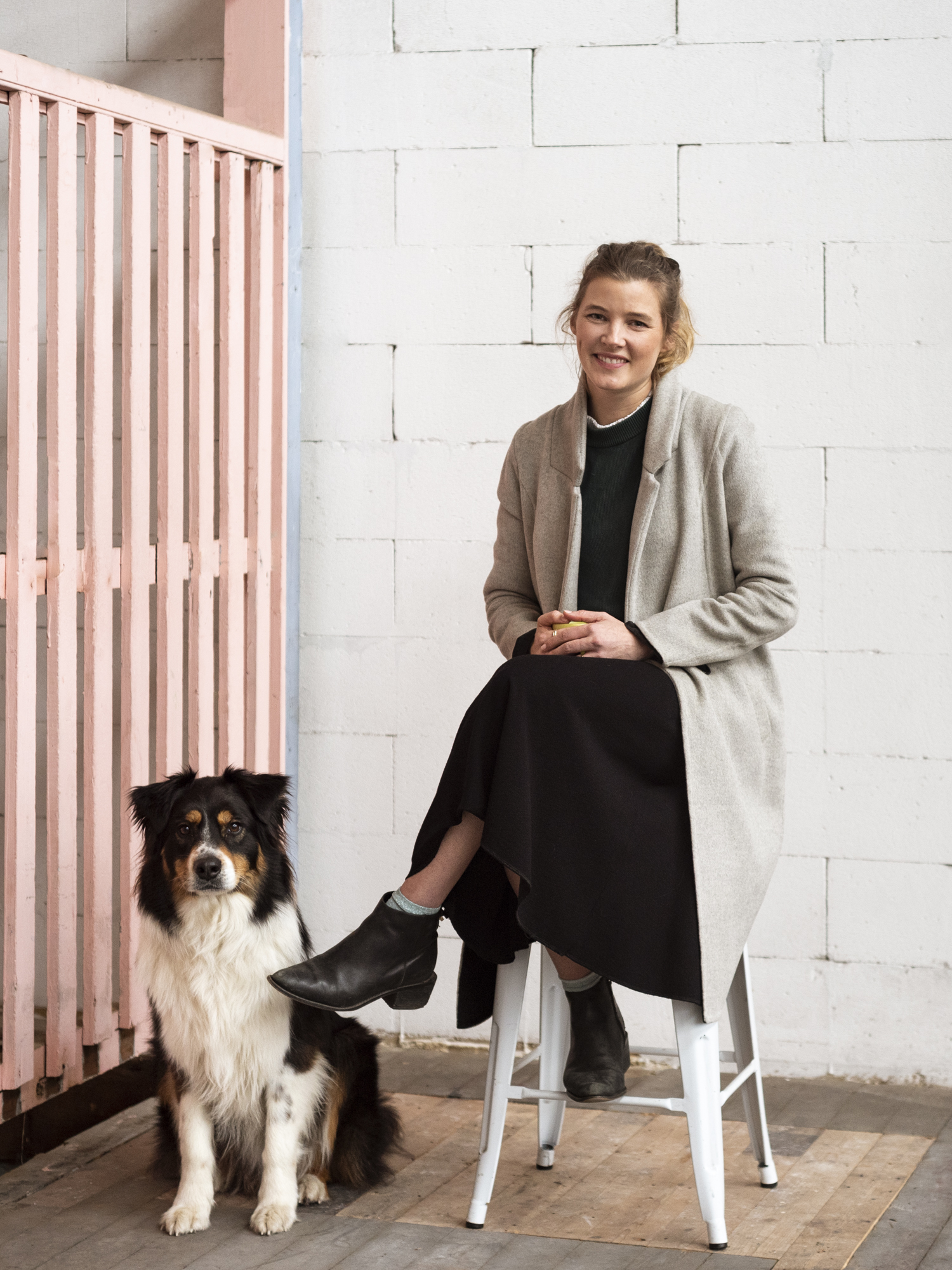News
Founder Feature : Dirt
This article was originally published in issue 01 of Duct Tape Mag
A publication from our friends at Start-Up Vic, and Victoria University.

Getting Your Hands Dirty. Laundry liquid with a mission.
In 2016, Frankie Layton had an epiphany. Why was there not an environmentally friendly laundry liquid, free from harsh chemicals and excess packaging, that was also affordable, AND actually cleaned your clothes? So after years of working in marketing and advertising, and exploring the impact of non-profit work, Frankie founded The Dirt Company, turning her love of the ocean and passion for sustainability into a household product that could do it all.
Refill And Return
“We sell laundry detergent on subscription, mostly direct to consumer. The whole objective of the product design is to reduce as much plastic packaging as possible, or keep reusing it. We have an aluminium dispenser bottle that can be refilled through refill packs. The refill packs, although they do contain plastic, contain remarkably less plastic than a bottle, and because the laundry detergent is super concentrated, you’re looking at reducing the amount of plastic per load by up to 10 times. Then our customers send back their refill packs to us and we sanitise them, reuse them, and send them out again, so there’s a zero waste component to our system.
“If you’re buying something you’re having an impact on the earth. It’s not about creating no harm or being completely footprint-free, it’s about finding formulas where you can make a significant difference. If one percent of the population started using our product, we would be saving 50 tons of plastic from being manufactured. That’s just one percent of the population who buy liquid laundry detergent, and also excludes people who return their refill packs. It’s a system that does significantly less harm compared to the way society currently operates.
“We are really looking to launch new products and to build out that refill and return program. At the moment, we do pay extra labor costs and processing fees. It’s not yet the most economically viable program, but rather something that we do as an innovation experiment. We’re looking at ways that we can make that side of the business more commercially viable. One of the ways is developing new products and getting slightly bigger baskets, another is getting people to buy and send back more at a time.
“When you’re trying to build a business that’s rooted in good values, it’s a lot more expensive. For example, an aluminium bottle at $2 versus a plastic bottle at 20 cents – you have to wear those costs and it gets tiring because you’re like, ‘Well, I know how to make this work. I could just get the 20-cent ones.’ You have to sit so firm in that bigger picture. So we look at what we’re going to do next and how it might make a significant impact.”

Looking Out To Sea
“I grew up in Melbourne’s inner eastern suburbs. I was into sciences at school, so I enrolled in a behavioural neuroscience degree at Monash, but spent a gap year working on superyachts in Europe, crossing the Atlantic Ocean from the South of France to the Carribean. I had this idea when I finished school that I was going to start a foundation for youth that were struggling with mental health, but the owner of the boat that I worked on was a pretty successful businessman. I told him about my dream and he said, ‘That’s just the dumbest thing I’ve ever heard. How are you going to make money? What you need to do is to start a business. You need to make a lot of money, and then you can spend your money on things you want to do’. I do think that’s an old-school way of thinking, but it was one of the things that really stuck with me – if I want to do something good, I have to find a sustainable way to fund it.
“I returned from the gap year not only with a new sense of the relationship between enterprise and impact, but I’d also fallen in love with the ocean, and the images of floating patches of garbage left a marked impression on me. We used to just throw bags of garbage overboard, and you’d have schools of dolphins at the front of the boat and just be chucking trash over the back.
“I found myself somewhat lost when I returned to Australia to attend university. Searching for the fastest way to get a degree, I ended up with a Bachelor of Arts from Monash University, which was phenomenal because I just got to study things I liked – psychology, criminology, marketing – but left me completely directionless in terms of career. I have always had an interest in working for purpose, but that interest probably got shut down a little bit with the ‘you need a way to make money’ thinking, but the connection to the ocean never really went away. I’m just one of those people that’s an ocean baby.
“I got a job at Red Bull throughout university. It was like a crash course in guerilla marketing techniques. Almost everybody who I worked with there turned into entrepreneurs themselves. They’d basically say, ‘Here’s a rule book, now go figure out how to break it and get some Red Bull in people’s hands’. We had to give away 120 Red Bulls in a day – so we hustled. We’d trade our way into the best events, so that we were right in the target audience hotspot. There were directives around it, but as long as you were getting Red Bull in hands, no one cared too much how you did it – everyone was happy.”

When Charities Make Things Worse
“In your early twenties, all you try to do is just make a buck and get by, have as much fun as you can. So after a few years of university at Monash, I ended up following a boy to Germany, and finishing my studies there. After a while, I realised I was going to need to be sponsored to stay in the country, which meant I had to get my first job out of school. That’s how I ended up in advertising. I was literally throwing my resume at anyone that was willing to give me a go. I did what was supposed to be a three-month internship, but after six weeks they agreed to sponsor me.
“I found the marketing and advertising problems I encountered interesting, especially things that would keep CFOs awake at night – the way that you’d see it a dozen times, the world could shift and brands could fail to keep up. But the interest in working for purpose and entrepreneurial activities never went away, so I tried to start a unit called ‘Task Force’ within the German marketing agency that explored offering pro-bono advertising resources to charities to improve their brand and marketing appeal.
“I remember it was late at night in Germany, but a reasonable time in Sierra Leone, and we had tracked down the West African correspondent for the BBC to talk to him about how we would go about the pro-bono charity work. We were working in one of Germany’s top advertising agencies, and we were going to ask them to dedicate a week of resources to a charity. We needed to know how to select and how to vet charities, to work out who we should donate money to. To our surprise, our contact said that we simply should leave the country alone. ‘Do-gooders’, as he called them, were a big part of the problem.
“He said that charities are one of the reasons why governments don’t feel that they have to fix the problems. So the project stalled, and we weren’t sure what to do.”
Loyalty In The Laundry Aisle
“After four years in Germany, I returned to Melbourne and began working with a friend who had just started a marketing agency. We were doing really well, but I realised I didn’t want to run an agency. I found myself more interested in what the client was doing than what I was doing and that felt like the wrong position to be in. So that’s when I decided that I needed my own product business. But I didn’t really know what it was, and so I ended up taking a four-day-a-week job back in advertising, and Wednesdays off to figure out what that other thing was going to be.
“The idea for The Dirt Company came from trying to shop for my housemate who had sensitive skin. I was looking closely at the laundry detergent aisle for the first time ever. Before it had been a ‘just grab whatever the tag says’ sort of decision. I was always a liquid detergent person, but it really started to frustrate me that you would buy these big tubs that looked cheap, but didn’t have many loads in them and you’re just throwing out heaps of plastic. They didn’t have to disclose their ingredients on the label, and it was hard to lug home a two-kilo bottle on a bike. We couldn’t switch to powder at that point because it’s wasn’t great for sensitive skin. I also found the cleaning category particularly interesting because there were no brands that stood out to me – the whole category hadn’t evolved much. I thought there was a need being met across different brands in different ways, but not a solution that made me want to continue buying. There was just no brand loyalty for me in the detergent aisle.
“At the same time, Who Gives a Crap had just launched and they were doing a direct to consumer offer. It was really smart. A product that you know you need all the time that you might as well get delivered to you. Their success really lowered the barrier of entry to the category because you didn’t need to have a distribution deal with a supermarket to find your own customers.”
My Product Is Better Than Yours
“After six to eight months of exploring gaps in the cleaning category, I decided to focus on laundry detergent. It’s not our long-term plan to only offer detergent, but I really believe in the minimum viable product and lean startup and all the rest of it, so laundry detergent is where we’ve started.
“I spent 12 months writing business plans, making brand ideas, and basically just fluffing about. I kept trying to find reasons why it wouldn’t work. Once I had solutions for all of these reasons, I felt that I had a strong idea. For example, I’d present myself with a problem like ‘people don’t want to pay more for laundry detergent’. Then I’d go through it, look at the costs again, and think, well, if we could get the concentrate down to this amount, meaning that they only needed this much, then it’s going to make sense to them that it is actually cheaper on a cost-per-load basis. So what if we did a model where our first product was competitively priced, but introduced you to the idea of using less and lasting longer – paying a bit more upfront and getting longevity out of every purchase? It was just a process of thinking about all the reasons somebody wouldn’t buy it and finding a rebuttal that was rooted in logical sense.
“We started thinking about what makes us really fall in love with a product. We needed to present several points of interest to capture a universal appeal. Convenience, a feel-good factor, an appealing design, ease of use, and a great performance standard – these were all categories we put a lot of focus on. I ended up making a spreadsheet called ‘Why My Product Is Better Than Yours’. I went through all the competitors and tried to find true reasons why my product would be better than them. I used Amazon reviews in the USA for any kind of international products that I was looking at. I used Choice and Product Review Australia for local products. Online reviews will give you a pretty good reflection of what the sentiment out there is. So I didn’t just make up things about the product. I tried to find why people loved them, why people hated them, tried to match a reason for why people could love my product, and tried to resolve a problem for everything that people didn’t like about the current ones they were using.
“That’s also how I formatted the brief for the formula. The chemist told me that he’d never met anyone that came with such a thorough brief of what they were after, that usually people come with things like, ‘Oh, we’re going to do an eco-range, can you do that?’ I came with a full list of who it needed to beat on each specific claim. I remember he came back and said, ‘Look, we’ve hit everything here, except for grass stains. We’ve underperformed against this person on grass stains, but everything else is good’, and I was like, ‘Nope, this has got to work for everyone, take it back. We need it to hit grass stains’, and we’d do it again.

Breaking Through and Breaking Down
“I was working at Ogilvy when I started exploring Dirt. The best part was having a job, so there’s no pressure to launch it at any point. The worst part was having a job, so you have no time to launch it at any point.
“I quit Ogilvy in June 2017. I was only working four days a week, but I wasn’t really getting my fifth day to work on Dirt and it was getting impossible to continue. On the day of launch, I sold like 20 laundry detergents. Then I sold 10. Then I sold 6. I totally freaked out and got another consulting job for three days a week, and did Dirt in those other days off. Then in December we got really busy again – we’d go back to selling 20 or 30 laundry detergents on some days, and I’d have to come home from work and pack them for distribution. I had Airtaskers waiting for chemicals here and couriers moving things there.
“I pretty much had a breakdown eventually. We had markets on the weekends and like five weddings that month, consulting work was heating up, and Dirt was turning into more than a two-day-per-week gig. I remember going to the Coburg Night Market – I drove my car there, nearly had an accident and it just set me off. I couldn’t stop crying. People were coming up to me at the market and asking, ‘So what have you got here?’, and I’d just put my head under the bench or turn around and walk away. We had to leave the market because I was in such a bad way.
“That was when I decided I couldn’t keep doing both. Dirt was gaining momentum, but very limited by the fact that I didn’t have time to move anything forward. Everything was just in a state of steady chaos. So I decided in January, I would completely quit working and give Dirt a focused six months. If I couldn’t make it work in that time, then I would return to work and that would be fine. In that December, we were turning over $4,000 a month. By the end of that six months, we were at around $20,000. It made a difference. We’re at least five times bigger.”
The Counterintuitive Price of Growth
“We started growing really quickly between June last year and February this year, like 30% every month. I did not anticipate the pressure that put on the cash flow – we had to buy some of our products with up to 12-week lead times, and because we hadn’t been around for more than a year, and had a slowish first six months where there wasn’t much business at all, our suppliers had come to think of me as another person with a startup that probably wasn’t ever going to get it off the ground. So they weren’t in a hurry to put us on great trade deals – they weren’t going to give us product before we could pay for it.
“We have this model where the first purchase comes at a very low margin for us, so we have to wait three months on average for the customer to come back and purchase their first profitable basket. I remember thinking, ‘I can’t believe this, we’ve just hit $30,000, $40,000, $50,000 and so on. Where’s the money going?’ There was progressively more money coming into the business, but there was no money to pay for anything. I really underestimated that cash flow lag and that growth is expensive. I remember we had a slower month in February this year, and I said to my business partner, ‘Oh, we’re not going to hit our growth target this month, but in other news, the bank account is looking really great’. It’s so counterintuitive.
“I didn’t actually realise that we had to be earning around $70,000 a month to be able to cover costs. I didn’t have any notion of that. I thought I was going to start the business with $30,000, we’d buy stock and we could use some money from our first sales to buy our second stock.
“We’ve bootstrapped the business. I think if you want to go the VC-funding route, you’re accepting that you’re on a certain course to grow and grow and grow. I’d prefer to be sustainable in our growth. We’re not slow growing, but we’re not unicorn level, and we still spend such a small amount on marketing. I like that because it means we feel everything and we grow at a certain pace. I’ve got a business that I want to hold on to, that I want to use to create a great lifestyle for the people that are involved in it, and I want to stay true to this vision with the flexibility to execute however we feel. That may not always align with the most financially strategic decision and I want that to be okay, and that’s why funding scares me. I don’t think that there’s many VCs out there that would be tolerant of that behavior, but I could be really wrong. That’s why it’s not out-out, it’s just that I don’t aspire to have that level of growth. If it happens, well, that would be awesome, and if it would happen on our terms, that would be the best. If it happened, but not on our terms, that would be the worst.”
A Well of Others’ Wisdom
“I think people feel worried about sharing their idea or thing that they’re working on. But I was really lucky, or maybe just the right fit for this, because I talk to everybody and love introducing people. Laundry detergent isn’t a novel idea – maybe if it were the next Uber, I would have been a bit more tight lipped about what I was trying to do, but I’m a Chatty Sue and I spread it all over town. I found people tend to want to help you in the same way you want to help them when they’ve got a question. The more people I told, the more doors opened up. For example, I rattled my idea off to a friend of mine, and it turned out that her dad was a member of the Chemical Association of Australia. So I met up with him a couple of times and he advised me on all the problems I should watch out for when building a chemical product.
“I believe that none of the wisdom that’s led to my success is really my own. From what my first boss on the superyachts told me, to the way that I’ve learned to work, to the people I’ve collected that help steer the ship, I’ve taken all that from others. Dirt is definitely my baby in terms of ideas, but I did not get it off the ground on my own at all. I borrowed money from my dad, who put in the initial equity. Then there’s Josh, my other co-founder, who used to sit in front of me at Ogilvy.
“The reason I quit my job the second time was that a friend told me, ‘You’ve got to go so deep, that it would cost you more to turn back’. That made sense. For me that looked like six months without work, after which I would have to go back with my tail between my legs, $50,000 down, knowing I tried the thing and it didn’t work. That felt motivating enough to give it a real crack. If I hadn’t gone that way and just kept working, I would have been giving myself an out. I could always fall back on the excuse that work got too busy and I didn’t have time to get it off the ground. I think you have to be able to stand behind a sense of ‘I tried this. I gave it a go’, whether it ends up working out or not. Honestly, I’m just amazed how long I can stay interested in laundry detergent.”

 Account
Account